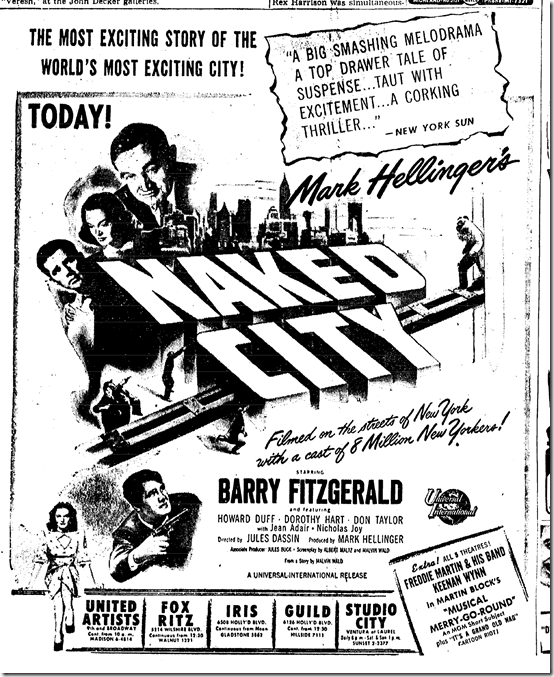
March 10, 1948: “Naked City” opens in Los Angeles. Credit: Los Angeles Times
Several years ago, when Kim Cooper of the 1947project and I were briefly discussing a book, I did some research on film noir, particularly “Naked City,” the last movie by producer Mark Hellinger, who died Dec. 21, 1947, at the age of 44. At one point, I went through microfilm of old issues of American Cinematographer to see how World War II had changed the movies.
Reading the 1947-48 Cinematographer articles was a profound experience because they strip away all the layers of over-intellectualized, uber-aesthetic, DVD Web page claptrap that have been written about film noir over the years.
The motives and the causes were simple and easy to understand, and frankly most of them were workmanlike solutions to workmanlike problems: Crews had become accustomed to shooting on location — in combat or making training films — often with minimal lighting and small, 16-millimeter cameras.
There was also a strong emphasis on naturalism, with actual locations, real people and minimal makeup. One of the films that came out of this new perspective was “Naked City” for which William Daniels (d. 1970) won an Academy Award for black and white cinematography.
Here’s what I mean: The Cinematographer article on “Naked City” from 1948. Everything that Daniels (often described as “Garbo’s photographer”) did was for the simple reason of telling a story, with minimal lighting, real locations and crowds of actual New Yorkers. Even the majority of the cast had little previous exposure on film.
Notice one other hallmark of the film noir in “Naked City”: The movie is narrated, though not by one of the characters (like Walter Neff in “Double Indemnity” or Joe Gillis in “Sunset Boulevard”) but an external observer, Hellinger.

Photo: Mark Hellinger and Jules Dassin during production of “Naked City.” Credit: American Cinematographer
By Herb A. Lightman, American Cinematographer, May 1948.
THESE are words in praise of a man and a motion picture. The man is the late Mark Hellinger — and the picture is his last and best film, “The Naked City,” now in release by Universal-International.
It is hard for cold words on paper to pay tribute to the intensely human personality of Mark Hellinger. To those of us who were fortunate enough to know him, he always seemed more like a symbol than a mere mortal. He personified The Big City, the brashness of the prohibition era, the “stop-the-presses” school of journalism. Like his contemporary, the late Damon Runyon, he was a bard of the modern age -a chronicler of the complex, urban, sometimes-hysterical 20th Century in America.
His short stories, of which he wrote one a week for many years, were savory slices of life, jacked with humor and pathos and the emotions of just plain people. He wrote of the “guys and the dolls,” the “bums and the molls.” His reputation as a “square guy” won for him the respect of government and police officials as well as that of New York’s supposedly most venomous underworld characters.
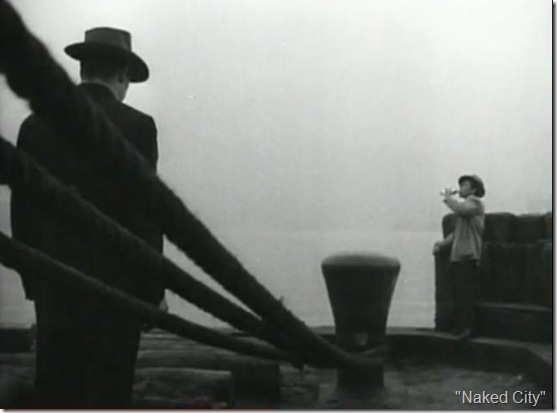
The mooring lines make dramatic diagonals in this shot, and the bollard blocks the view of the beating.
As a person, Hellinger was as genuine as a silver dollar fresh from the mint. His colorful vocabulary gave voice to a dynamic personality, and when he talked you hung on every word-no matter what the subject: His words were plain, and sometimes profane-but they were rich and warm and descriptive, and there was heart in them. It was natural that his particular brand of genius should find expression in the dramatic medium of the motion picture. For the past several years a Hollywood producer, he was just beginning to hit his best stride with pictures like “The Killers,” “Brute Force,” and now “The Naked City.” His passing though a great personal loss to those of us who knew him as a friend — is an even greater loss to a motion picture industry which, at the moment, sorely needs the original, vital, and human touch which he brought to the screen.

March 11, 1948: Philip K. Scheuer reviews “Naked City” in The Times. Dec. 22, 1947: Mark Hellinger dies.

East Side, West Side
Mark Hellinger was a clever short story writer, an imaginative film producer but first and foremost, he was a good reporter. He was happiest when chasing down a hot news story, the kind of yarn that millions of people would read next morning while gulping their coffee or hanging from a subway strap. He had a favorite stomping ground, New York City — and he loved it with a faithful passion, just as a Frenchman loves the boulevards of Paris, or an Irishman loves the emerald hills of Erin. It is fitting, then, that his last picture should be a newspaper story on film, with New York City as its locale.
That “The Naked City” was a labor of love is evident from the moment the opening scene appears on the screen. There are no credits, no title, no lettering of any kind — just an aerial shot of Manhattan at dawn. Then, Hellinger’s voice is heard on the sound track explaining that this is the story of a day in New York. He speaks just as he would speak to a crony down at Joe’s Bar and Grill, commenting on the urban scene with simple, direct and richly descriptive words. We see the great city struggling to wakefulness — yawning, sitting up and rubbing its eyes.
Then we see the milk-man making his rounds, the crowds rushing for the subway, the wheels of urban commerce slowly beginning to turn. Finally, settling down to the crux of the narrative, the camera noses its way through the window of a hotel room where a young woman is being slowly and systematically strangled by two thugs.
From that point on, the camera goes behind the scenes to show the step-by-step unraveling of the mystery by a venerable detective (played by Barry Fitzgerald ) and his young assistant (played by Don Taylor).
But to say that “The Naked City” is just another whodunit, is to make a brazen understatement, for the crime itself and its ultimate solution is secondary to the background against which it is portrayed.

The killing of Jean Dexter is almost too dim to be visible and all we see of the drowning is water being run into a bathtub.
The film is primarily a story of New York; not the New York the tourists see when herded about from Rockefeller Center to Chinatown by harassed guides wishing for an easier way to make a living. It is not even the New York of the native Gothamite, grown (like the tree) in Brooklyn — or born and bred in the shadow of Manhattan’s spires.
It is the New York of the police reporters, those unsung worshipers of the typewriter who exist from deadline to deadline. Behind the graphically journalistic, often staccato, approach of the camera, one can see the Mark Hellinger of fifteen years ago doggedly following up the story of a socially insignificant young woman who was strangled and left floating in a bath-tub full of water.
It is the kind of everyday murder you read about in the front page headlines and forget by the time you’ve turned to the comic page. And yet, projected as it is against the backdrop of a reporter’s Manhattan, it becomes documentary drama — and intensely stimulating screen-fare.
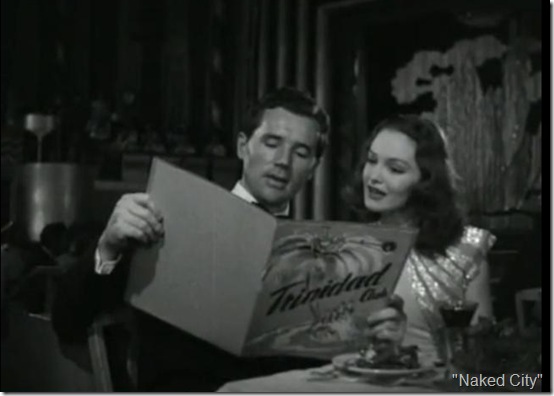
Howard Duff as Frank Niles and Dorothy Hart as Ruth Morrison in “Naked City”
The Soul of the City
Jules Dassin, who directed the film, is, like Hellinger, a native New Yorker. His understanding and affection for the sprawling metropolis underscores the flawless technique he has used in etching the story’s action onto celluloid. He has captured the sprightly pace so typical of Manhattan, the sordid claustrophobia of the lower East Side. He has blended realism and drama into a perfectly balanced narrative that fits neatly into its vast setting, but never becomes lost in it.
The picture is full of clever little directorial touches that are solidly in key with the atmosphere of the locale. The camera pauses to watch kids splashing about in noisy ecstasy under a street hydrant; it eavesdrops as a couple of stenographers press their noses against the window of an exclusive dress shop and wonder aloud (in wistful Brooklyn accents) as to how they would look in the particular creation on display. The little people who make up a great city are not shunted aside as so much atmosphere they are given a voice in the telling of the story, and what they say is important.

Filming on location in tight quarters: Barry Fitzgerald’s tiny kitchen in “Naked City.”
Of the three month shooting schedule allotted to the script, two and a half months were spent in New York where the greatest bulk of the action was filmed. As a result, all of the settings (including interiors) are absolutely authentic — a fact that is bound to delight New Yorkers at home and abroad. Unusual locales included the Williamsburg Bridge, the Bellevue Morgue, and the scaffolding of a building under construction twenty three floors above the street. The result is exactly what Mark Hellinger intended it to be: a film that shows New York as New Yorkers know it.
During the hour and a half running time of the film, the audience sees more of New York than it would see on a week’s sightseeing tour of the city. It is estimated that twenty billion dollars worth of “sets,” including Manhattan’s impressive skyline, make their appearance as backgrounds to the action. A record crowd of 200,000 spectators watched the street scenes being filmed.

Another tight location: Filming on an elevator at a building under construction.
Of the twenty-four featured roles in “The Naked City,” only four are portrayed by Hollywood actors. Twenty prominent parts were filled by New York radio and stage actors, most of whom were making their first screen appearances. The unstudied acting of these players is uniformly excellent, and the fact that their faces are not familiar adds greatly to the realism of the picture.
One of the more bothersome problems which director Dassin had to contend with was the crowds that gathered whenever the camera crew set up shop. Ropes were used to hold back the spectators, but when the mobs became unruly, a juggler was installed some distance away as a “decoy” to attract their attention. Further adding to the discomfort of the cast and crew was the fact that filming was done in June, July, August and September, during some of the hottest weather in New York’s history.
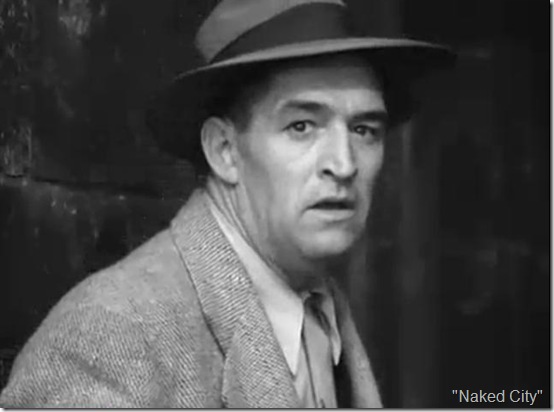
A dramatic close-up of Ted de Corsia during the famous chase sequence in “Naked City.”
The climactic sequence of the picture is a chase extending for a mile and a half between a tenement apartment on the East Side to the Delancy Street entrance of the Williamsburg Bridge. This is one of the longest and most difficult chase sequences ever attempted, and required three weeks of filming. It takes the audience through alleys, over fences, across a lot full of tombstones, and finally reaches its climax when the fugitive is cornered high up in one of the towers of the bridge. In order to line up this sequence along a quarter mile span of bridge, director Dassin used roller skates.
From the Camera Angle
William Daniels, A.S.C., whose outstanding work as Director of Photography on “The Naked City” is winning unanimous acclaim within the film industry itself, is a veteran of 30 years in the studios. Twenty-three of these were spent at M-G-M where he shot 92 features and became known as a top-notch “glamour” cinematographer. His realistic handling; of the photography in “The Naked City” is a complete about-face from the softly lighted, glossily diffused type of approach he used to employ as Garbo’s special cameraman.
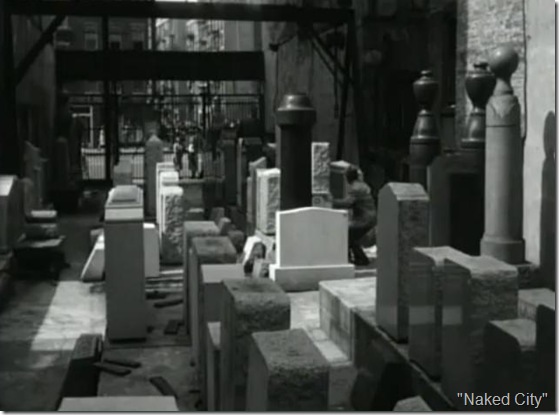
Part of the chase leads through a lot full of tombstones in a sequence that took three weeks to shoot.
His work in the Hellinger film is a happy combination of dramatic composition and realistic lighting-coupled with the fact that he worked very closely with the producer and director in the preplanning stages as well as during actual production. He has nothing but respect for director Dassin because of the line co-operation he received and the free rein he was given in the selection of locales, camera angles and the establishment of mood through lighting. The unusual rapport which existed between these two technicians is evidenced by the smooth manner in which the photography complements the journalistic style of the action.
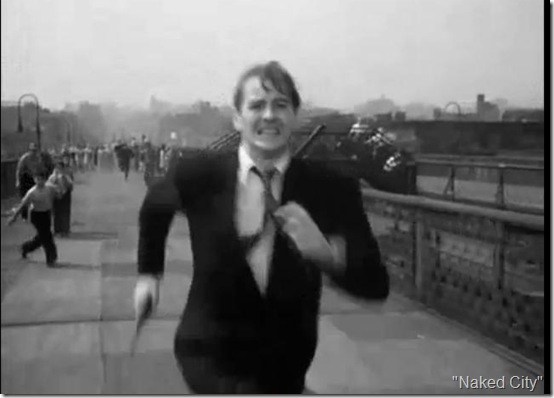
Don Taylor as Detective James Halloran in the final chase sequence of “Naked City.”
Director and cinematographer went to New York two months before shooting began in order to select locales that not only fit the story, but were also interesting from the photographic standpoint. Daniels was given final authority in the choosing of these backgrounds. Speaking of his overall approach to the film, he says: “We were after — well, let’s call it realism. I dislike the term ‘documentary’ because the word has come to mean badly shot 16mm. footage.
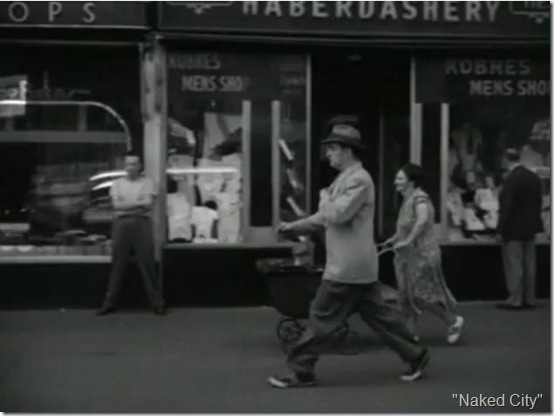
The camera truck appears to be faintly reflected in store windows in this shot.

In order no accentuate realism in his visual approach, Daniels photographed the actors without makeup. His lighting style was so simple as to be almost radical from the Hollywood production point-of-view. He had constructed at the studio portable metal frames into which could be screwed four ordinary RAP2 photoflood bulbs. These easily transported units not only added to the realistic style of the photography, but made it possible to shoot sequences in rooms that would not have accommodated any other type of lighting. The scenes in the tenement house, for example, were shot in a five by nine foot room. In many cases, ordinary building current was sufficient to run the lights, but two army surplus generators were taken along on location where more current was needed than could be furnished by local power facilities.

A lingering shot emphasizes the height of the Williamsburg Bridge – and that there’s no good way down for this killer.
As has been pointed out, one of the major problems was to conceal the camera so that crowds of curious onlookers would not clutter up the composition. This was accomplished by means of a panel truck whose sides were actually two-way transparent mirrors. The cameraman shot through the mirrors without the subject even suspecting that he was being photographed. Because of the density of the mirrors, two full stops of increased exposure were required.
The dusk and night shots in “The Naked City” are especially well done and reflect a good deal of expert planning. Usually there was a period of only about ten minutes during dusk when such scenes could be photographed. The cameraman and not the director decided when the sky had developed just enough glow so that the buildings would stand out against it, and it was the cameraman who gave the signal for “Action!” when such scenes were being filmed. The sequence showing the mother and father of the murdered girl departing from the city was rehearsed all day long and shot with three cameras during five minutes of twilight when the sun starts to drop behind Manhattan’s skyline. On the screen, this sequence has a luminous quality that is very striking.
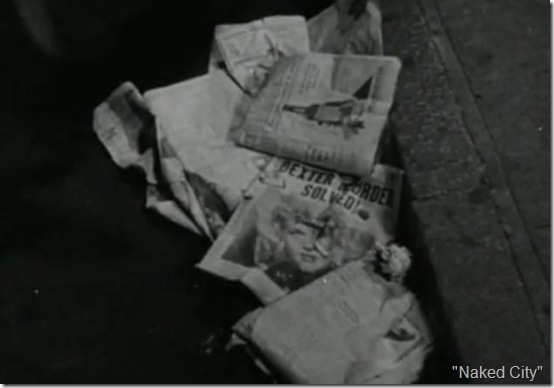
“Dexter Murder Solved!” … and the newspaper goes into the trash.
Nearly a quarter of a million feet of film was exposed during filming of the New York sequences, due to the unpredictable conditions under which shooting took place. Many famous buildings of the city were photographed for the last time, having since been demolished to make room for the United Nations building. The skyscraper shown to be under construction in one sequence is the new Universal-International building at 57th St. and Park Avenue. These scenes were shot atop a scaffold twenty-three stories above the street and the director, cameraman and stars had to ride the material hoist in order to get and ascending shot called for in the script.
Photographically and directorially “The Naked City” rates with the best films of the year. But it is more than an interesting evening at the theatre. It is a tribute in celluloid to Mark Hellinger, a swell guy.
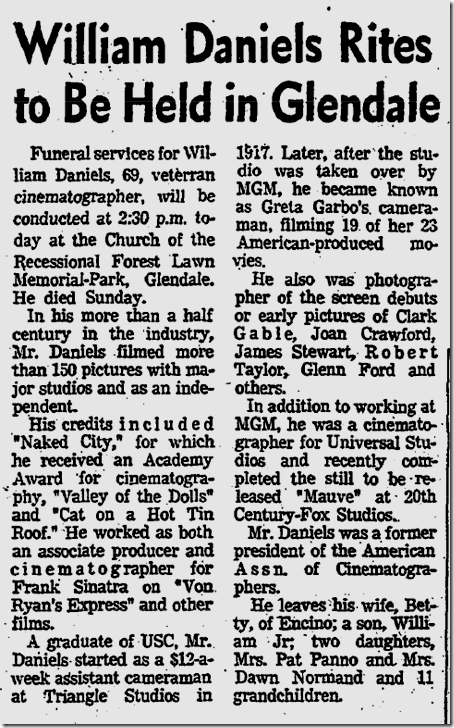
June 17, 1970: Services for cinematographer William H. Daniels at Forest Lawn Memorial-Park in Glendale.


THE NAKED CITY is not a Film Noir; it is a police procedural filmed in the Italian Neorealism style that became famous globally in 1946 with Roberto Rossellini’s ROME, OPEN CITY.
As film historians know, the Western and the Movie Musical are Hollywood’s only inventions. All other genres and styles were created and developed in Europe and Russia.
Film Noir is not a production term like Western or Musical. Coined by French critics, it identifies a film about a loser – not a hero – who struggles against a destiny he cannot control. The Loser is basically decent,but flawed, and frequently embraces his own destruction, usually with the help of a designing woman. DOUBLE INDEMNITY beautifully defines the genre code. As does THE ASPHALT JUNGLE. In THE NAKED CITY the good guys win; the bad guys lose. That’s why it became a successful TV series, like LAW AND ORDER, ect. Or does every gritty film and TV show become film noir?
A full discussion of Film Noir (one of my personal favorites is the French, SERIE NOIRE, taken from a Jim Thompson novel but re-titled in homage to the genre) involves philosophy, psychology and story telling as well as film techniques, issues that The American Cinematographer is as acqainted with as is the American Sound Techician.
Might I suggest that for your next Brain Trust Luncheon you pick a topic for discussion, such as Film Noir, with attention to specific films?
LikeLike
@B.J.: Excellent post, thanks! Of course, your definition would exclude “The Maltese Falcon” and “Laura,” two classic films of the era in which the “good guys” win.
I attended a presentation on Raymond Chandler several years ago in which Kenneth Turan said that the term “film noir” has become so diluted as to be meaningless. Might be a good topic for a future luncheon.
LikeLike
Excellent and well researched article. I’m in New York, and every time I cross the Williamsburg Bridge, I think of the famous chase scene, though by now the bridge has been so remodeled that it looks almost nothing like it does in the film.
LikeLike
@Steve; I’ve Love the film – I think it’s of the best ever made. Do you know if the ‘old streets’ from where the “tombstone lot” to the Williamsburg bridge – still exist as they are in the film (houses etc) ? What streets are these? Is the “tombstone Lot” a Cemetery (definately Jewish) or a Monument vendor? Is the place still there? Does the soda shop where Don Taylor Det. Jimmy Halloran, still exist? Can you name the streets that were passed through? .
Thanks for any information; I truly loved this film. I’ve found a website which shows some locations then and now, but falls short of the areas I’ve asked about (the ones at the end of the film from where Halloran is search for Willie Garzah; from the ‘Ice cold root beer Lady’ through to the Williamsburg bridge.
Thank You Very much and thanks for the great article by lmharnisch
Hans. hansgreeber at g mail dot com.
LikeLike
The tombstone lot was between two building on East First Street. As you look at the photo there is a black gate which is the exit on East First Street and across East Houston Street, where there’s a playground, which the detective looking for the bad guy walked by and then ran across East Houston Street and onto East First Street, entering the tenement building where the bad guy lived. To the left is Avenue “A” South of Avenue A, is East Houston Street, and where Essex Street starts. leading south to the food markets, Delancey Street and the Williamsburg Bridge. On the other side of the tombstone lot where the bad guy ran and jumped the fence is East Second Street between A & B. I know because I lived there in1951-1955 and then again in the late ’60s. A block west of East Houston and Essex is Katz’s Deli.
LikeLike
Hey thanks for writing!
LikeLike
Joe’s answer is backed up by maps and other photos I have seen. The tombstone lot was a display area for the Steinberg and Dubin monument company. Its name is in Yiddish on the sign in front, which you see as Halloran crosses from the park. This company (which still exists, in NJ, I believe) had its offices directly across Houston at the corner of Norfolk St. (Just up Norfolk from the Hungarian synagogue). And just east on Houston was a funeral home. NYPL has a photo: http://digitalcollections.nypl.org/items/b4afdefd-4a2f-146a-e040-e00a180610a2
As Halloran walks across from the park, he passes a small triangular island of buildings between east First and Houston. This is no longer there, as the tenements he was walking toward are no longer there. Houston east of Essex was widened some time after this, and after ’55. A Bromley map at NYPL shows the buildings as of ’55, with a narrow Houston to the east. Houston to the west had been widened for the Subway in the 30s. The block with Garzah’s tenement and the monument lot was redeveloped, and part of it was taken for a wider Houston St. Now there is a new building there called “Red Square.” The monument display lot was near where the main entrance to the new building is, it appears. After this the scene shifts to Delancey street before there are too many landmarks to identify. Aside from Essex Market, the indoor market. I am not sure which one Garzah goes through; there are two, and one is being demolished for the new Essex Crossing development south of Delancey. Notice that when he calls in from the corner store, he says he is on Norfolk, between Houston and Rivington? They probably wanted to show how excited he was, because Stanton St is between Rivington and Houston; he spoke in error. I appraise apartment buildings down there; just did one on Clinton recently.
LikeLike
Hey thanks! You and John Bengtson should get together!
LikeLike
You are right about the importance of post-war Italian Neo-Realism, it was quite revolutionary at the time compared to gloss and unreality of the Hollywood golden age studio system. It is almost forgotten about today. If you aren’t familiar with it, try THE BICYCLE THIEF.
Many think of John Huston as inventing film noir with THE MALTESE FALCON in 1941. Story and structure make it film noir and there are endless arguments about what makes a film “noir or not.” Film noir more properly takes place in the mind of the cinema goer.
I think Larry is quite correct about the experience of filmmakers during WWII. However, wasn’t the success of almost all shot on location THE TREASURE OF THE SIERRA MADRE, released in Jan. 1948, which had the studios relenting and allowing more films to be made on location, rather than Italian Neo-Realism? John Huston was the director with the power and the charisma and the storytelling ability. Of course Huston was also one of the outstanding filmmakers who used no artificial light and fast 16mm as he chronicled WWII in his WWII documentaries, so he knew how to do it.
Also, I think technically it was MGM’s THE ASPHALT JUNGLE, also by the incredible and often taken for granted John Huston, which spawned or re-invented the noir caper film.
On a only somewhat related note: isn’t it extremely sad if not disgusting that so many otherwise seemingly intelligent people in their 20s-40s these days *refuse* to watch any black and white films, ever? These young people refuse to look or consider all the incredible achievements of nearly a century of film, and upon which everything in media today is built. Sort of like refusing to consider the entire history of ancient Greece and Rome and the impact on the idea of democracy, just because you don’t like men in togas.
Young people today don’t even know or understand that film IS an art form (or was). While video, and color of course, remain a medium for witless hacks who make garbage like “Transformers”, and the ignorant children who think real film starts with color in the 1960s.
LikeLike
Obviously not a noir, but “Best Years of Our Lives” was similarly done on location in Cincinnati (mainly) and used minimal makeup for the actors.
LikeLike
Goo point Larry.
It was a Samuel Goldwyn production. Like Mark Hellinger, Goldwyn had taste. As an indie he also had more freedom, could be quicker and was a bit more innovative than the majors. So you can see how the Golden Age was looking pretty worn out and much less related to people’ daily lives by 1946. The experience of WWII was such an upheaval for the US. You can see that play out as film became more suddenly more realistic and naturalistic.
But here is the whole point: that film noir could only blossom thanks to a really cynical, adult, post WWII mindset. Americans at the time were way ahead and much more sophisticated than the bland, censored, escapist fair of the Depression. This left Hollywood scrambling to catch up to its audience (which will happen again the late 60s and 70s).
Of course today, Hollywood is so “advanced” what with all these fancy special effects! Today where all major Hollywood films are only made for 14 year old boys who watch 55+ hours of violent videogames every week.
LikeLike
The immediate postwar era was a particularly transformative time for the U.S. Like all industries, the studios were about to experience an upheaval with organized labor (i.e. the Technicolor strike) and the new rival in the living room: Television. Most of the big bands were giving way to duos, trios and small combos. The “greatest” generation was abandoning the cities to raise their boomer families in cookie-cutter homes in the suburbs.
It was also an era of extreme uncertainty from the beginning of the Cold War and fear of Communism; and there were a lot of veterans who were mentally unbalanced or had trouble readjusting to civilian life.
In an era like that, another “Andy Hardy” or Deanna Durbin picture is pretty irrelevant.
But remember, it wasn’t that long ago (OK, well it was the late 1970s) that the studios were blaming Pac-Man and other video arcade games for cutting into their attendance.
Today, the biggest threat to movie theater attendance is a 42-inch flat screen, a Blu-Ray player and Netflix. People really don’t care to spend this kind of money for a movie ticket and be subjected to jerks in the audience with cellphones or who talk through the film.
LikeLike
@Imharnisch “Today, the biggest threat to movie theater attendance is a 42-inch flat screen, a Blu-Ray player and Netflix” I agree – and I am one who does not attend commercial theaters – but there are some arthouse theaters nearby which i occassionally attend. Reason for avoiding chain theaters: is convenience, and poor audience. However, is was due to Netflix that I discovered film-noir and have enjoyed many great ‘old black and white films’ thanks to Netflix. Some great B&W crime films “The Killing”; “Where the sidewalk ends”; “Down three dark strees” – and many others. Home viewing is growing and film watching is clearly transforming it is not dying and I can’t percieve anything negative to it, except the loss of large theater facilities. In addition to the stories, one thing i’ve discovered I enjoy is seeing what the country looked like in the post war to early 60’s. I find it unintentionally very beautiful to see the old stores, motels, modes of dress that existed then. I pray I’m not getting a nostalgia bug for an era I didn’t live in, but I guess there can be worse things in life.
LikeLike
Thank you, Imharnisch. I was also an NYPD cop, as well as a Port Authority cop and NYS correction officer, working at Sing Sing. So I know the Naked City well. My bio is on Wikipedia: Joe Sanchez…and my Website is: http://www.bluewallnypd.com Best to all this coming Christmas, Happy Hanukkah, and Happy New Year!
LikeLike